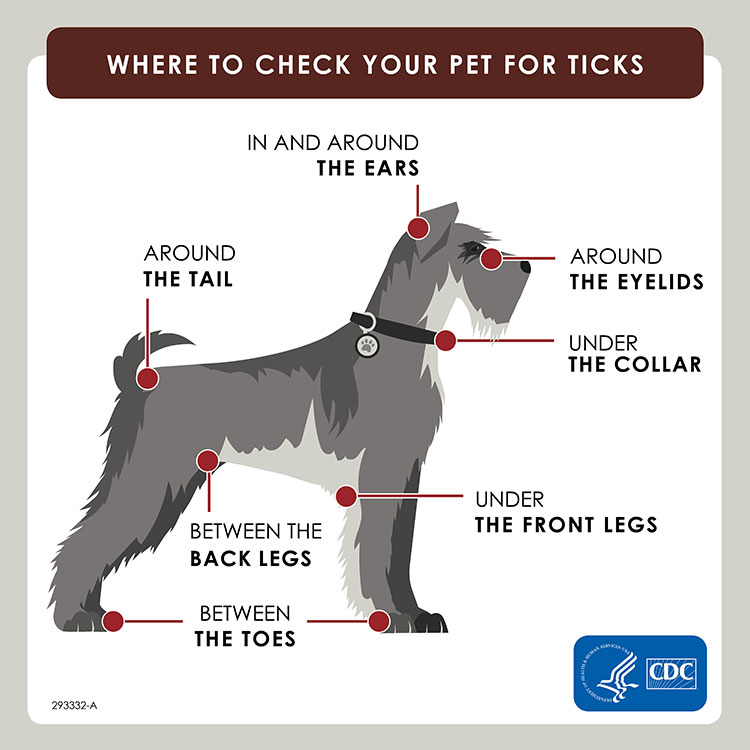There are a few simple measures you can take to help keep you safe from ticks around the home.
Remove leaf litter and invasive plants. This helps to eliminate tick habitat. Invasive plants such as Amur honeysuckle and multiflora rose are associated with high tick numbers.
Keep grass short. Sunlight reaching the soil surface helps to keep the soil dry, which discourages ticks.
Keep patios, playgrounds, and other recreational areas away from tall trees. Ticks thrive in shaded areas.
Keep the yard free of trash. Debris may attract rodents, which in turn may harbor ticks.
If you spray insecticide to kill ticks, be sure to follow all label instructions. Remember that the label is the law. While careful, selective application of chemical products can help control ticks, it’s important to consider non-target impacts. Many acaricidal products can also kill beneficial insects such as pollinators.

Ticks vector numerous pathogens that affect dogs, cats, and other animals, so it is important to keep your pets up-to-date on tick preventive products.
Talk to your veterinarian to find the best tick prevention product to use. Available products include topical (“spot on”) treatments, oral treatments (pills or chewables), dusts, sprays, and acaricide-impregnated collars.
Note that some products developed specifically for dogs are not safe for cats.
Limit your pets’ exposure to tick habitat. Keep cats indoors whenever possible and don’t allow dogs to wander into tall grass or dense vegetation.
Check your pets for ticks when they come indoors after being in tick habitat. If you find a tick, remove it promptly.
There are various tick population control methods available. But there’s no single, universal approach that addresses all needs. The best plan is a combination of approaches as part of an Integrated Pest Management (IPM) plan.
For any approach, consider several factors:
Manage or alter vegetation to make backyard habitats less attractive for ticks (e.g., make conditions drier). Clear tall grasses and brush. Remove leaf litter. Mow your lawn often. Create barrier strips of wood chips or gravel between lawns and wooded areas.
Important Note
Only acaricide products registered for tick control by the EPA and the Delaware Department of Agriculture should be used. And, in accordance with federal and state law, all product label requirements and conditions for application must be followed.
Wise use of acaricides (pesticides that kill ticks) can effectively control ticks. These are usually longer-lasting products. They are sprayed on shrubbery, lower tree trunks, ground cover or lawns, fences, undersides of decks or porches, etc.
Homeowners can apply some acaricidal products. Others require a certified pesticide applicator.
Based on Lyme disease risk, the best treatment months are May or June. A single application can be enough for control throughout the season.
Use only products labeled for wide-area tick control. Follow all label directions.
Pyrethroids are the most effective acaricides against ticks. They are used on woody edges where lawn borders forest, groundcover vegetation such as Pachysandra, and along stone walls.
Such barrier spray treatments can also kill non-target insects and other invertebrates, though. More research is needed to determine the magnitude and consequences of this approach.
Researchers are investigating the use of natural enemies to control ticks. These might include parasitic wasps, nematodes, fungi, and various microbial pathogens.
Some believe that domestic chickens and guinea fowl can control ticks. But scientific evidence backing these claims remains scant.
Research continues. These control agents are not commercially available.
Reducing deer populations to less than 20 deer per square mile can help reduce the risk of tick bites. Deer are tick-host animals.
Deer population densities in protected suburban areas can range from 30 to 60 per square mile.
Regulated hunting can help to reduce deer overpopulation. But, hunting for deer control is not workable in all locations or communities. There are safety and liability concerns and possible social acceptability issues.
Deer can be discouraged on residential property using fencing, deer resistant plantings and deer repellents.
These devices consist of a station baited with corn to attract deer. When the deer feed, their heads and necks brush against paint rollers that apply a topical acaricide.
Studies have shown that this technique can reduce numbers of blacklegged and lone star ticks.
Deer feeding stations can pose a risk of disease transmission between wildlife species. They are not legal in some states but are legal on private lands in Delaware.
This approach is labor intensive and might not scale-up well for widespread use.
Tick tubes are cardboard tubes containing cotton balls treated with the insecticide permethrin. Tick-hosting rodents, such as white-footed mice, use the cotton as nesting material. The permethrin kills ticks on the mice.
This technique targets blacklegged ticks but is not very effective on lone star ticks which don’t usually feed on rodents.
This approach can be labor intensive and might not scale-up well for widespread use.
Bait boxes contain food blocks which attract rodents that serve as tick hosts. Rodents entering the box contact an applicator wick which applies fipronil (an insecticide) to the rodent to kill ticks.
As with tick tubes, this technique targets blacklegged ticks but is not very effective on lone star ticks which don’t usually feed on rodents.
Some studies have shown that bait boxes can increase local rodent numbers by providing an additional food source.
This approach can also be labor intensive and might not scale-up well for widespread use.
A recent approach is to inoculate tick-host animals with a vaccine that prevents Lyme disease pathogens in rodents.
This involves scattering vaccine-laced food pellets in mice habitats or adding them to mice-feeding stations.
This approach might not work well for rodents already carrying Lyme disease
More research is needed to determine how effective this vaccination approach might be. There may also be FDA registration matters.
This approach could also be labor intensive and might not scale-up well for widespread use.
Related Topics: dfw, fish and wildlife, Health and Safety, home, tick